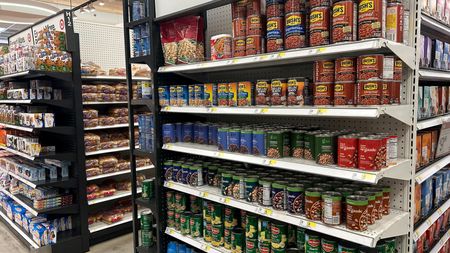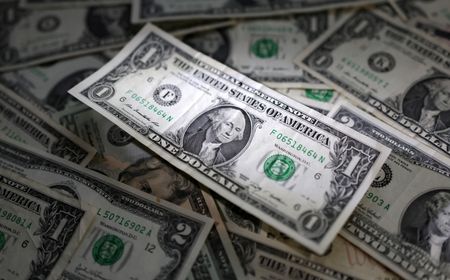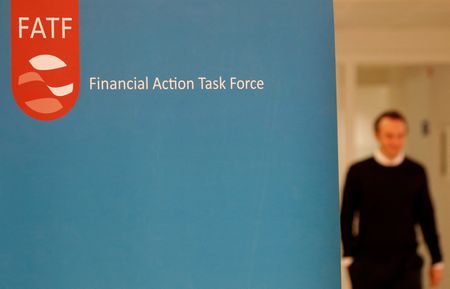NEW YORK (Reuters) -U.S. consumer prices rose slightly less than expected in September, preserving market expectations the Federal Reserve will cut interest rates at its policy meeting next week.
The Consumer Price Index (CPI) rose 0.3% last month after climbing 0.4% in August, the Labor Department’s Bureau of Labor Statistics said on Friday. In the 12 months through September, the CPI increased 3.0% after advancing 2.9% in August.
Economists polled by Reuters had forecast the CPI increasing 0.4% and rising 3.1% year-on-year.
Excluding the volatile food and energy components, the CPI gained 0.2% after rising 0.3% in August. The so-called core CPI increased 3.0% year-on-year after rising 3.1% in August.
The report was delayed due to the government shutdown but was eventually published in order to help the Social Security Administration calculate its 2026 cost-of-living adjustment for millions of retirees and other benefits recipients.
MARKET REACTION:
STOCKS: S&P 500 E-mini futures climbed and were last up 44.75 points, or 0.66%.
BONDS: U.S. Treasury yields initially fell before paring declines and the 10-year yield was last downunchanged to 3.989% and the two-year yield fell 1.5 basis points to 3.467%.
FOREX: The dollar index weakened and was last off 0.07% to 98.87.
COMMENTS:
JEREMY SCHWARTZ, SENIOR US ECONOMIST, NOMURA, NEW YORK:
“It was weaker than we expected, but I think a lot of signs of underlying inflation pressure are still there. So, some of the misses were driven by noisy rent components. We expect that you’re not going to get too much more disinflation from that.
“Meanwhile, tariffs do seem to be gradually passing into a lot of consumer goods prices. You saw apparel continuing to tick higher. That’s been one of the categories where the pass-through hasn’t happened so quickly, but we think it’s very likely to continue through year end. And so, the signs there of those lingering pressures are still pretty clear in this report.
“As long as you’re in that mode where you’re tolerating a little bit more inflation, this is a good report. This is going to encourage (the Fed) to keep on that path of insurance cuts or normalization, depending how you view it. In the absence of any other tier one data until the government shutdown concludes, I think it’s very likely that they deliver something close to the dot plot until the data can start to be published again to prove them otherwise.”
ERIC GERSTER, CHIEF INVESTMENT OFFICER, ALPHACORE WEALTH ADVISORY, RIVERSIDE, CONNECTICUT:
“It’s quite positive (the data) and going forward, it certainly clears the way for the Fed to cut rates next week as they were going to anyway and it certainly leads to a higher expectation of at least two more rate cuts (By March). With the government shutdown. we don’t have a lot of other data other than private data and so this is a good scenario for the Fed if inflation is maintaining at this level and not spiking that they can focus more on the employment.”
WASIF LATIF, CHIEF INVESTMENT OFFICER, SARMAYA PARTNERS, NEW JERSEY:
“So far the number seems to be a relief for the market because it came in less than expected, at least the headline number. And when you look at some of the components it looks housing contributed to some of the softness here. Without having a full picture across the other economic components, this data by itself is a relief and you see that in the futures market, bonds and commodities – gold is off its lows. It’s early in the session and we will see how the market digests the details of this number. But the initial reaction is good because it gives the Fed a little bit more breathing room to cut rates.
“Ultimately, this market has been driven by expectations of rate cuts. And as that breathing room for the Fed gets more and more, the market likes that because that is supportive of more liquidity through rate cuts and the possibility of other types of monetary accommodation. The bond market is down which helps in the fiscal side of things, helping with government funding and future bond auctions. So net and net, the number is good.”
MONA MAHAJAN, HEAD OF INVESTMENT STRATEGY, EDWARD JONES, NEW YORK:
“It’s nice to see CPI come in a tick lower than expectations. It gives the Fed a little more cover to pursue the rate cutting path it outlined in September even with the lack of full labor market data. Some of the trends that we did see in reports like ADP or even the ISM survey data have shown some softening in labor, and the CPI data today helps confirm that we’re not seeing an outsized move higher in inflation that could give the Fed some pause. So, that part of the story remains intact.
“The Fed is on this path towards neutral and probably wants to get the Fed funds rate somewhere in the three and a half percent range over the next year or so.
“We’re still above the Fed’s 2% target. We still have to see fully the tariff impact work through goods inflation. But goods makes up about a third of the CPI basket, and two thirds is services inflation, and that continues to look like it’s remaining contained. That’ll help support the overall narrative.
“We want to be mindful that we are in period of government shutdown, and the economy can slow during this period as well. Now this inflation data doesn’t reflect that quite yet, but we’ll be watching for that kind of slowdown in the economy as well.”
MARC CHANDLER, CHIEF MARKET STRATEGIST, BANNOCKBURN CAPITAL MARKETS, NEW YORK:
“The headline was a bit softer than expected. The dollar was sold on the news, even though the market had nearly 100% confidence before the report that the Fed would cut rates, not only next week, but in December.
“My guess would be that the dollar firms up again as the session progresses. Because the market has priced in the Fed cuts, this kneejerk pushback in the dollar I don’t think is going to be sustained.”
PETER CARDILLO, CHIEF MARKET ECONOMIST, SPARTAN CAPITAL SECURITIES, NEW YORK:
“These numbers reveal nothing new. Inflation remains sticky. The good news is that the core rate only rose 0.2% which was in line with what we were looking for, and on a year-to-year basis 3%.
“Headline inflation was in line with consensus, but the year-to-year was a little bit higher. This tells us that the tariff inflation continues to weigh on the consumer’s pocketbook and that inflation remains sticky, although it’s not running wild and that’s a good thing.
“In terms of the Fed, we’re looking at a 25 basis point cut next week and they will have enough time from now to December to evaluate the inflation data that is coming in and even if it’s delayed.
“But it’s quite clear that the Fed has indicated that for now they’ve abandoned the inflation fight to prop up the jobs market from deteriorating any further, which means further rate cuts ahead.”
JOE SALUZZI, CO-MANAGER OF TRADING, THEMIS TRADING, CHATHAM, NEW JERSEY:
“It was a good number and, I think, considering that we haven’t had anything over the past two or three weeks, people were getting a little anxious as to what this could have been. So you’ve finally got something and it kind of confirms everybody’s theory as to what’s going on. Inflation is relatively tame, right? And you’ve still got a problem in the jobs market, there’s no question about it, which I think is why the Fed is going to continue doing what they’re doing.
“It looks around 88% now for two more cuts this year. So, it’s gonna happen. Well, the market likes that. The S&P rallied pretty quickly. We got almost about seven tenths of 1% right now on the upside. So, overall, it’s good. It keeps the fuel in the rally. It could have went the other way, right? Had we gotten a really hot number, then you could have had a potential big problem here. But, overall, I’d say the market is really liking this one.”
(Compiled by the Global Finance & Markets Breaking News team)










